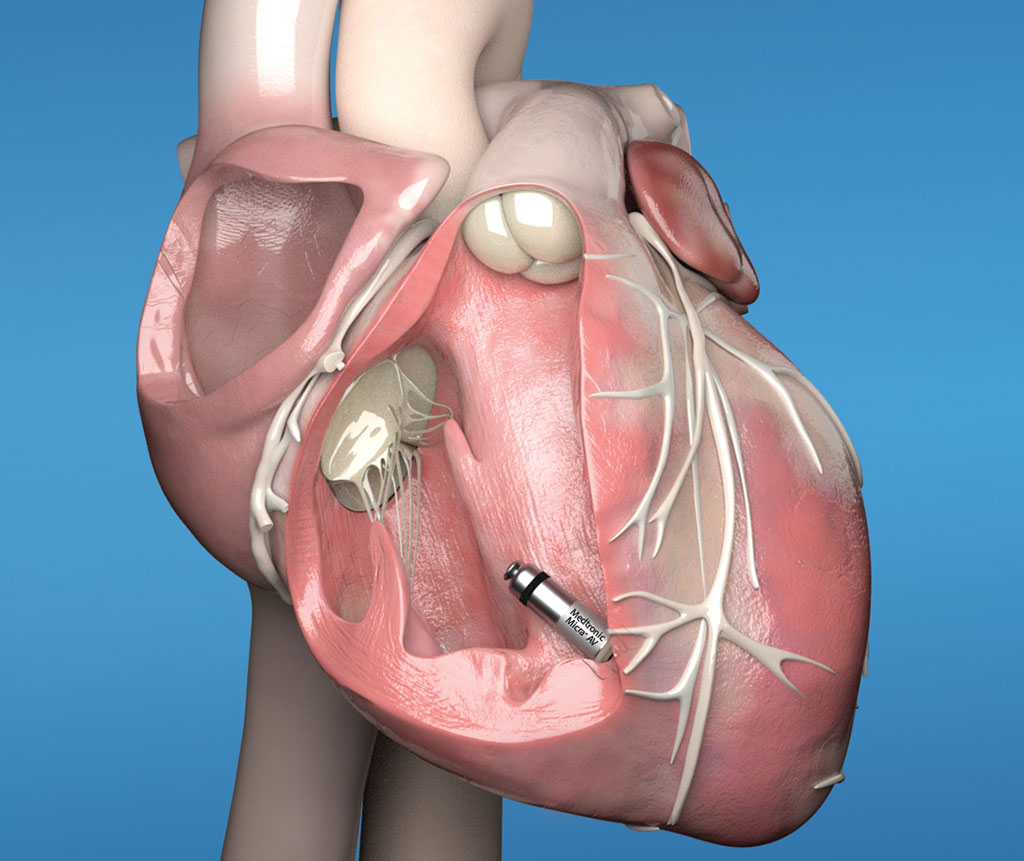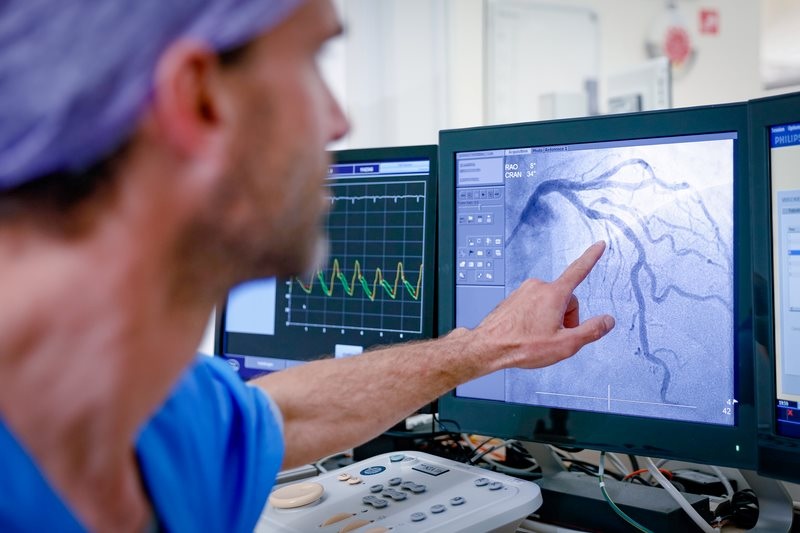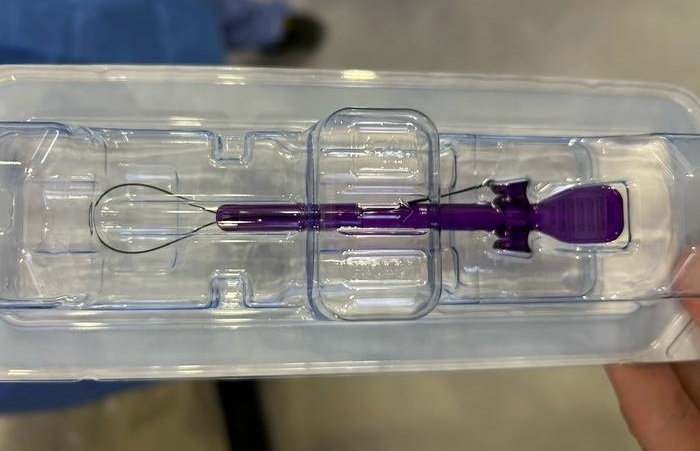Dual-Chamber Implanted Pacemaker Detects Cardiac Movement
|
By HospiMedica International staff writers Posted on 03 Feb 2020 |

Image: The Micra AV leadless pacemaker with internal atrial sensing algorithms (Photo courtesy of Medtronic)
A miniaturized device offers patients with AV block an advanced leadless technology at one-tenth the size of a traditional pacemaker.
The Medtronic (Dublin, Ireland) Micra AV provides atrioventricular (AV) synchrony capabilities, thanks to a built-in three dimensional (3D) accelerometer that can sense the back and forth movement of the heart, and can therefore coordinate pacing of the ventricle that it is synchronized with the contractions of the atrium. The Micra AV pacemaker is identical in size and shape with the original Micra Transcatheter Pacing System (TPS), with an estimated 12-year battery life, and is approved for full body 1.5 and 3 Tesla scans magnetic resonance imaging (MRI) scans.
Micra AV is delivered via a minimally invasive percutaneous catheter through the femoral vein and is then positioned inside the right ventricle, directly attached to the heart via small nitinol tines that hold it and the electrodes in place; it can be repeatedly repositioned to make sure that heart activity and low electrical thresholds are at optimal levels. Once positioned, the device responds to patients' activity levels by automatically adjusting therapy. And as it does not require a subcutaneous surgical pocket to be created, potential complications are eliminated.
“Since revolutionizing medicine with the first battery-powered cardiac pacemakers, Medtronic has continued to develop pioneering pacing technologies, culminating in the first miniaturized, leadless pacing portfolio for physicians and their patients,” said Rob Kowal, MD, PhD, of the Vascular Group at Medtronic. “The introduction of Micra AV reinvents our own innovation, bringing the many benefits of leadless pacemakers to more patients.”
“With the approval of Micra AV, more pacemaker patients qualify for a new treatment option that offers the advantages of leadless pacing, including a minimally invasive implant procedure and a cosmetically invisible device,” said cardiac electrophysiologist Larry Chinitz, MD, director of the NYU Langone Heart Rhythm Center (New York, NY, USA). “Although complications with traditional pacemakers are infrequent, when they occur, they’re expensive to treat and can be invasive for the patient. Real-world use of Micra has shown a 63% reduction in major complications compared to traditional pacemakers.”
Within the right atrium of a normal heart is a natural pacemaker that sends an electrical stimulus that travels from the pacemaker (SA node) to the ventricles (AV node). In the presence of an AV block the transfer of the electrical nerve conduction that regulates the normal, rhythmic, pumping action of the heart muscle is interrupted or slowed. If the heart block occurs in the fetus or newborn, the condition is known as congenital heart block.
Related Links:
Medtronic
The Medtronic (Dublin, Ireland) Micra AV provides atrioventricular (AV) synchrony capabilities, thanks to a built-in three dimensional (3D) accelerometer that can sense the back and forth movement of the heart, and can therefore coordinate pacing of the ventricle that it is synchronized with the contractions of the atrium. The Micra AV pacemaker is identical in size and shape with the original Micra Transcatheter Pacing System (TPS), with an estimated 12-year battery life, and is approved for full body 1.5 and 3 Tesla scans magnetic resonance imaging (MRI) scans.
Micra AV is delivered via a minimally invasive percutaneous catheter through the femoral vein and is then positioned inside the right ventricle, directly attached to the heart via small nitinol tines that hold it and the electrodes in place; it can be repeatedly repositioned to make sure that heart activity and low electrical thresholds are at optimal levels. Once positioned, the device responds to patients' activity levels by automatically adjusting therapy. And as it does not require a subcutaneous surgical pocket to be created, potential complications are eliminated.
“Since revolutionizing medicine with the first battery-powered cardiac pacemakers, Medtronic has continued to develop pioneering pacing technologies, culminating in the first miniaturized, leadless pacing portfolio for physicians and their patients,” said Rob Kowal, MD, PhD, of the Vascular Group at Medtronic. “The introduction of Micra AV reinvents our own innovation, bringing the many benefits of leadless pacemakers to more patients.”
“With the approval of Micra AV, more pacemaker patients qualify for a new treatment option that offers the advantages of leadless pacing, including a minimally invasive implant procedure and a cosmetically invisible device,” said cardiac electrophysiologist Larry Chinitz, MD, director of the NYU Langone Heart Rhythm Center (New York, NY, USA). “Although complications with traditional pacemakers are infrequent, when they occur, they’re expensive to treat and can be invasive for the patient. Real-world use of Micra has shown a 63% reduction in major complications compared to traditional pacemakers.”
Within the right atrium of a normal heart is a natural pacemaker that sends an electrical stimulus that travels from the pacemaker (SA node) to the ventricles (AV node). In the presence of an AV block the transfer of the electrical nerve conduction that regulates the normal, rhythmic, pumping action of the heart muscle is interrupted or slowed. If the heart block occurs in the fetus or newborn, the condition is known as congenital heart block.
Related Links:
Medtronic
Latest Critical Care News
- Miniature Non-Invasive Robotic Catheters to Improve Infertility Treatments
- Stick-On Patch Monitors Baby's Movements In Utero
- EEG-Based AI Technology Accurately Diagnoses Alzheimer’s and Dementia
- Robot Lymphatic System Paves Way for Self-Powered Wearables and Machines
- Focused Ultrasound Technique Successfully Treats Pediatric Brain Cancer
- Nasal Drops Fight Brain Tumors Noninvasively
- AI Helps Optimize Therapy Selection and Dosing for Septic Shock
- Glowing Bacteria ‘Pills’ for Detecting Gut Diseases Could Eliminate Colonoscopies
- Skin-Permeable Polymer Patch Delivers Insulin Non-Invasively Through Skin
- Nanogel Technology Almost 100% Effective in Destroying Drug-Resistant Bacteria Within Hours
- Wearable Ultrasound Sensor Delivers Noninvasive Treatment Without Surgery
- Gel-Free ECG System to Transform Heart Health Diagnosis
- Biodegradable Patch Repairs Damaged Tissue After Heart Attack
- Magnetically Guided Microrobots to Enable Targeted Drug Delivery

- Smart Nanomaterials Detect and Treat Traumatic Brain Injuries Simultaneously
- Earlier Blood Transfusion Could Reduce Heart Failure and Arrhythmia in Heart Disease Patients
Channels
Surgical Techniques
view channelLaparoscopic Surgery Improves Outcomes for Severe Newborn Liver Disease
Biliary atresia is a rare but life-threatening liver condition in newborns that blocks bile flow and leads to progressive liver damage if not treated early. Surgery is typically performed within the first... Read moreNovel Endoscopy Technique Provides Access to Deep Lung Tumors
Detecting lung cancer early can save lives, but diagnosing small tumors deep in the outer regions of the lungs remains a major clinical challenge. Although CT scans frequently identify tiny suspicious... Read morePatient Care
view channel
Revolutionary Automatic IV-Line Flushing Device to Enhance Infusion Care
More than 80% of in-hospital patients receive intravenous (IV) therapy. Every dose of IV medicine delivered in a small volume (<250 mL) infusion bag should be followed by subsequent flushing to ensure... Read more
VR Training Tool Combats Contamination of Portable Medical Equipment
Healthcare-associated infections (HAIs) impact one in every 31 patients, cause nearly 100,000 deaths each year, and cost USD 28.4 billion in direct medical expenses. Notably, up to 75% of these infections... Read more
Portable Biosensor Platform to Reduce Hospital-Acquired Infections
Approximately 4 million patients in the European Union acquire healthcare-associated infections (HAIs) or nosocomial infections each year, with around 37,000 deaths directly resulting from these infections,... Read moreFirst-Of-Its-Kind Portable Germicidal Light Technology Disinfects High-Touch Clinical Surfaces in Seconds
Reducing healthcare-acquired infections (HAIs) remains a pressing issue within global healthcare systems. In the United States alone, 1.7 million patients contract HAIs annually, leading to approximately... Read moreHealth IT
view channel
EMR-Based Tool Predicts Graft Failure After Kidney Transplant
Kidney transplantation offers patients with end-stage kidney disease longer survival and better quality of life than dialysis, yet graft failure remains a major challenge. Although a successful transplant... Read more
Printable Molecule-Selective Nanoparticles Enable Mass Production of Wearable Biosensors
The future of medicine is likely to focus on the personalization of healthcare—understanding exactly what an individual requires and delivering the appropriate combination of nutrients, metabolites, and... Read moreBusiness
view channel
Philips and Masimo Partner to Advance Patient Monitoring Measurement Technologies
Royal Philips (Amsterdam, Netherlands) and Masimo (Irvine, California, USA) have renewed their multi-year strategic collaboration, combining Philips’ expertise in patient monitoring with Masimo’s noninvasive... Read more
B. Braun Acquires Digital Microsurgery Company True Digital Surgery
The high-end microsurgery market in neurosurgery, spine, and ENT is undergoing a significant transformation. Traditional analog microscopes are giving way to digital exoscopes, which provide improved visualization,... Read more
CMEF 2025 to Promote Holistic and High-Quality Development of Medical and Health Industry
The 92nd China International Medical Equipment Fair (CMEF 2025) Autumn Exhibition is scheduled to be held from September 26 to 29 at the China Import and Export Fair Complex (Canton Fair Complex) in Guangzhou.... Read more















